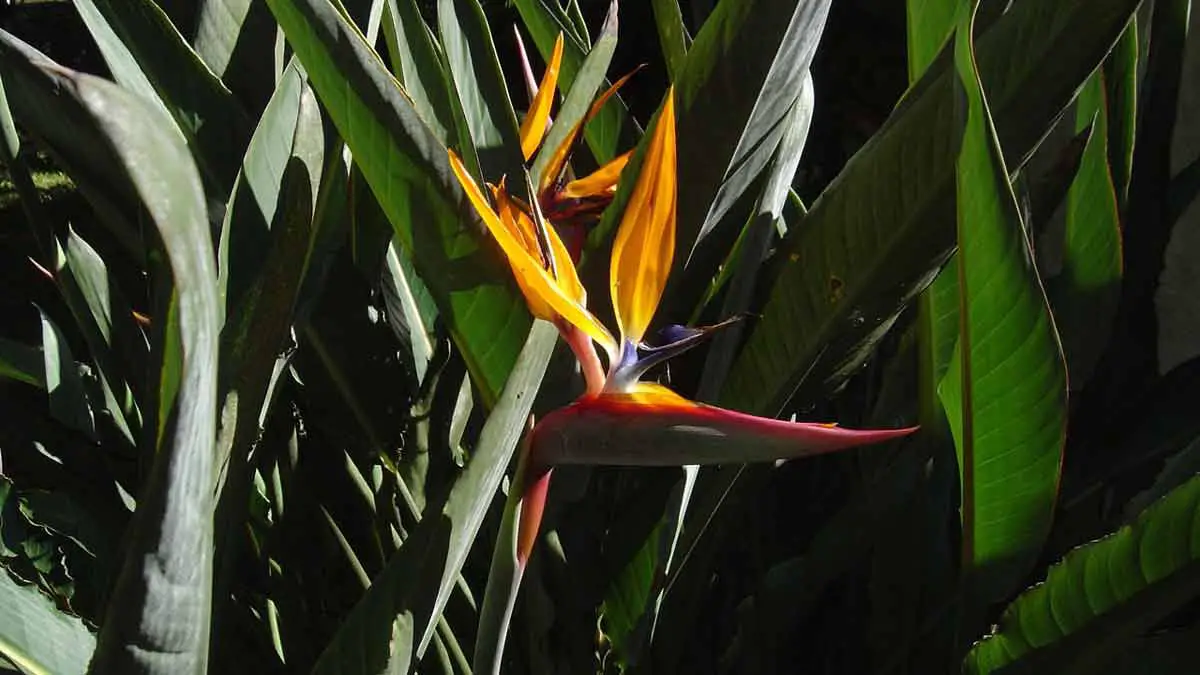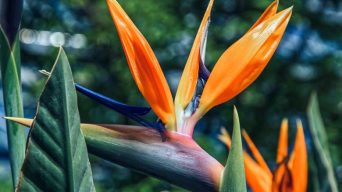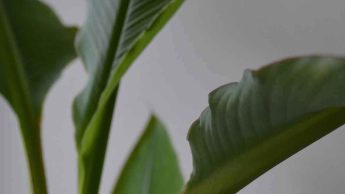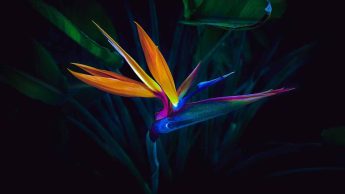Bird of Paradise (Strelitzia reginae) is a beautiful houseplant native to South Africa.
The plant gets its name from its stunning flowers, which resemble the head of a tropical bird.
The Bird of Paradise is a popular houseplant because it is relatively easy to care for and can tolerate neglect better than most other plants.
However, even the tough Bird of Paradise can suffer from problems, including black spots on its leaves.
What Causes Black Spots on Bird of Paradise Leaves and How Can You Fix It?
If you notice black spots on your Bird of Paradise leaves, it is crucial to figure out the cause to treat the problem effectively.
The most common causes of black spots on Bird of Paradise leaves are too much water, pests, or disease.
Here are some of the most common causes of black spots on Bird of Paradise leaves and what you can do to fix the problem:
1. Too Much Water
One of the most common causes of black spots on Bird of Paradise leaves is too much water.
The Bird of Paradise is native to South Africa and grows in sandy, well-drained soil.
The plant does not like to sit in wet, soggy soil for long periods. If the roots of the plant are constantly wet, they will begin to rot.
This can lead to black spots on the leaves and leaf drop, and stem death.
The most common signs that your Bird of Paradise has been overwatered are black spots on the leaves, yellow leaves, and root rot.
How To Treat an Overwatered Bird of Paradise
If you think that your plant has been overwatered, the first thing you should do is stop watering it.
Allow the soil to dry out completely before you water your plant again.
You should also repot your plant in fresh, well-drained potting mix.
Be sure to use a pot with drainage holes to allow any excess water to drain out.
2. Fungal Diseases
Fungal diseases are another common cause of black spots on Bird of Paradise leaves.
The most common fungal diseases that affect Bird of Paradise plants are black spot, sooty mold, leaf spot, and anthracnose.
Fungal infections are usually caused by too much moisture or poor air circulation.
The fungi thrive in warm, wet conditions and can spread quickly to other parts of the plant.
Black Spot
Black spot fungus (Diplocarpon rosae) is a type of plant disease that is caused by a member of the fungus kingdom.
The black spot fungus gets its name from the small, black spots it produces on infected leaves.
These spots may be surrounded by a yellow halo, which can eventually lead to leaf drop.
Black spot fungi are most commonly found on roses, but they can also affect other types of plants, such as tomatoes, beans, and peonies.
While black spot fungi are not usually lethal to plants, they can cause significant damage and make the plant more susceptible to other diseases.
How To Treat Black Spot Fungus
If you think that your Bird of Paradise plant has black spot fungus, the best thing to do is to remove any affected leaves.
Be sure to dispose of them in a trash bag, so the fungus does not spread to other plants.
You should also increase the air circulation around your plant by pruning it and removing any dead leaves or branches.
If the problem persists, you may need to treat your plant with a natural fungicide, such as neem oil.
Neem oil is a natural plant product that can control various plant pests and diseases, including black spot fungus.
Fungal Leaf Spot
Fungal leaf spot is a type of plant disease caused by fungi.
The fungi can infect plants’ leaves, stems, and fruits, and they often cause brown or black spots to form on the plant tissue.
Leaf spot diseases can weaken plants and make them more susceptible to other problems, such as drought stress.
Additionally, the spots can make the plant tissue more attractive to pests, which can further damage the plant.
How To Treat Fungal Leaf Spot
If you think that your Bird of Paradise plant has a leaf spot disease, you first should remove any affected leaves from the plant.
Dispose of them in a trash bag so the fungi cannot spread to other plants.
Next, water your Bird of Paradise plant at the base of the plant, rather than from above, to prevent water from splashing the leaves and spreading the fungi.
It is also important to avoid overcrowding your plants, as this can increase the spread of leaf spot diseases.
If you have mulch around your plants, make sure that it is not too thick, as this can hold moisture near the plant and promote the growth of fungi.
You can also use a natural fungicide, such as neem oil to treat leaf spot diseases.
Mix a small amount of the oil with water and spray it on the affected leaves.
Sooty Mold
Sooty mold is a fungus that typically grows on the honeydew secretions of aphids and other sucking insects.
The honeydew secretions provide an ideal environment for the sooty mold fungus to grow and proliferate.
Sooty mold will initially appear as small, black specks on plant leaves.
However, given time, the sooty mold will spread and cover the leaves in a thick, black coating.
While sooty mold does not typically kill plants outright, it can impede photosynthesis by blocking out sunlight. In addition, sooty mold can make plants more susceptible to other diseases and pests.
As a result, it is essential to control aphid populations to prevent the spread of sooty mold.
How To Treat Sooty Mold
To treat sooty mold, it is necessary first to address the underlying problem of pest infestation.
There are several ways to achieve this, including the use of insecticidal soap, neem oil, or horticultural oil.
These solutions will help kill the aphids and other pests secreting the honeydew on which the sooty mold fungus grows.
Once the pests have been controlled, the sooty mold can be removed by physically scrubbing it off the plant leaves with a soft brush.
In some cases, treating the plant with a fungicide may also be necessary to eliminate the sooty mold fungus.
Anthracnose
Anthracnose is a type of fungal disease that can affect a wide range of plants, including the Bird of Paradise.
This disease is caused by various fungi, all of which attack the leaves of the plant, causing them to develop black spots.
The spots are usually circular and can range in size from tiny dots to large patches.
Anthracnose can also cause the leaves to develop yellow or brown spots and become discolored and distorted.
The fungus can also attack the stems of the plant, causing them to become weakened and eventually die.
How To Treat Anthracnose
The best way to treat this disease is to prune away any affected leaves and stems.
You should also disinfect your pruning tools after each use to prevent the spread of the fungus.
It is also crucial to water your plant at the base rather than from above, as this will help prevent the disease’s spread.
If the problem is severe, you may need to use a natural fungicide to control the fungus.
Neem oil is a popular choice for treating anthracnose, as it is safe to use and will not harm your plant.
Baking soda can also be used as a fungicide, as it will help kill the fungi causing the disease.
Once you have treated the plant, you should keep an eye on it and prune away any affected leaves or stems as soon as they appear.
3. Bacterial Infection
Bacterial infections are another common problem that can affect the Bird of Paradise.
These infections are caused by various bacteria, all of which attack the leaves of the plant, causing them to develop black spots.
The spots are usually circular and can range in size from small dots to large patches.
Common bacterial diseases include bacterial leaf spot and bacterial blight.
Bacterial Leaf Spot
Bacterial leaf spot is a common problem affecting the Bird of Paradise.
This disease is caused by several different bacteria, all of which attack the plant leaves, causing them to develop black spots.
The spots are usually circular in shape and can range in size from small dots to large patches.
Bacterial leaf spot can also cause the leaves to become discolored and distorted.
The bacteria can also attack the stems of the plant, causing them to become weakened and eventually die.
How To Treat Bacterial Leaf Spot
The best way to treat this disease is to remove all affected leaves from the plant.
The bacteria can often be found in the soil, so it is essential to disinfect any tools that you use to remove the leaves.
After removing the affected leaves, you should treat the plant with a fungicide or bactericide.
You can use a natural product such as neem oil or a chemical product such as copper sulfate.
Make sure to follow the instructions on the label of whichever product you use.
The best way to prevent this disease is to ensure that your plant gets enough sunlight.
The bacteria that cause leaf spot thrive in shady, humid conditions.
If you live in an area with high humidity, you may consider installing a dehumidifier in your home.
You should also make sure to water your plant at the base and not from above, as this can encourage the growth of the bacteria.
Finally, clean up any fallen leaves or debris from around the plant, as this can also harbor the bacteria.
Bacterial Blight
Bacterial blight is a disease that can affect many different types of plants, including tomatoes, potatoes, and beans.
The most obvious symptom of bacterial blight is the appearance of dark, water-soaked spots on leaves and stems.
These spots will eventually turn brown or black and may drop off the plant entirely.
Bird of Paradise leaves may also become distorted or begin to curl up.
The bacteria that cause bacterial blight can be found in the soil, on the surface of plants, or infected seedlings.
The disease can spread quickly from plant to plant and can also be spread by water, wind, and insects.
How To Treat Bacterial Blight
If you think your plant has bacterial blight, taking action quickly is crucial.
Remove any affected leaves and dispose of them properly.
Avoid overhead watering, which can spread the disease.
Sanitize your gardening tools, and disinfect any pots or planters that have come into contact with the affected plant.
You can also treat bacterial blight with a copper-based fungicide.
4. Viral Infection
Viral infections are another common problem that can affect the Bird of Paradise.
These infections are caused by various viruses, all of which attack the leaves of the plant, causing them to develop black spots.
The spots are usually circular in shape and can range in size from small dots to large patches.
Viral infections can also cause the leaves to develop brown spots.
The viruses can also attack the stems of the plant, causing them to become weakened and eventually die.
How To Treat A Viral Infection
Unfortunately, there is no cure for viral infections.
The best you can do is remove all the affected leaves from the plant.
The viruses can spread quickly, so it’s essential to act fast.
You should also dispose of the affected leaves in a plastic bag so they can’t spread to other plants.
You may need to destroy the plant if the infection is severe.
5. Pests
Pests are another common problem that can affect the Bird of Paradise.
Various pests, including aphids, mealybugs, scale insects, and thrips, can infest the plant and cause the leaves to develop black spots.
These pests suck the sap from the leaves and leave behind a sticky residue that can attract sooty mold.
They can also inject toxins into the leaves that can cause the spots to develop.
Pests can also spread diseases from plant to plant, further damaging the leaves.
How To Control Pests
If you see any black spots on your Bird of Paradise, inspecting the plant for pests is essential.
If you find pests on your plant, there are a few different ways to get rid of them.
You can use a garden hose to blast the pests off the plant.
You can also remove them by hand with a cotton swab dipped in rubbing alcohol.
You can treat the plant with insecticide soap or neem oil if the infestation is severe.
They can also be controlled with natural predators, such as ladybugs, green lacewings, and parasitic wasps.
How To Prevent Black Spots On Bird Of Paradise Leaves
The best way to prevent black spots on Bird of Paradise leaves is to keep the plant healthy and free of pests.
Here are some tips to help you keep your plant healthy:
- Water the plant regularly, but be sure not to overwater it. Only water when the soil is dry to the touch.
- Avoid overhead watering, which can spread diseases.
- Use a well-drained pot or planter to prevent the roots from sitting in water.
- Place the plant in an area where it will receive bright indirect light.
- Place the plant in an area with good air circulation to prevent fungal infections.
- Inspect the plant regularly for pests and remove them promptly.
- Be sure to disinfect any gardening tools or pots that have come into contact with the plant.
- Fertilize the plant once a month during the growing season.
- Keep the area around the plant clean and free of debris.
Following these tips can help prevent black spots on Bird of Paradise leaves.
Final Thoughts
Black spots on Bird of Paradise leaves can be caused by various problems, including fungal infections, viral infections, pests, and overwatering.
If you see black spots on your plant, it’s important to inspect the plant and identify the cause.
Once you know what’s causing the problem, you can take the appropriate steps to fix it.
Taking good care of your plant and keeping an eye out for problems can help prevent black spots on Bird of Paradise leaves.







